#AI Generated Text Detector
Explore tagged Tumblr posts
Text
AI Tester Pro: Your Comprehensive Tool for AI Content Evaluation
Explore the capabilities of AI with ZeroGPT's "AI Tester." This tool offers users an interactive experience to assess and understand the effectiveness and accuracy of AI-generated content. Trust in ZeroGPT for comprehensive testing, providing valuable insights into the potential and quality of AI-driven interactions.

0 notes
Text
Our AI detector tool uses DeepAnalyse™ Technology to identify the origin of your text. Our experiments are still ongoing, and our aim is to analyze more articles and text.
#ai text checker#ai writing detector#chat gpt test#chat gpt zero detector#check ai generated content#ai generated text detector#ai detector free
1 note
·
View note
Text
Tips To Choose The Right Chat GPT Detection Tool For Your Business
ChatGPT is taking the world by storm. AI is a hot topic of discussion everywhere. If you are a business owner or a student, it’s possible that you know about the revolutionary changes this technology is driving. Chat GPT can improve customer experience, reduce cost, increase efficiency, and generate leads. Chat GPT has a lot of potential but we are just now learning about the potential downsides.
With the tremendous technological shift in how people work with Chat GPT while creating websites, apps, and even novels, there is caution to be exercised. We need to monitor abuse of Chat-GPT. Because it lets students pass their exams and submit their assignments. Writers now submit generative content, and researchers produce high-quality papers by typing prompts on Chat-GPT. AI Detection tools have come out to stop this abuse but many are not updated on a daily basis. Because of this, some can even generate false positives. Everyone needs AI-generated text detection tools that can deliver with a high degree of accuracy and ChatGPT detectors are now in high demand. You definitely need to catch cheaters but you also don’t want to accuse the innocent.
AI Detector Pro is software that effectively identifies text generated by Chat GPT. It is updated daily to so that it works on the latest version of ChatGPT and is already being tested on Bard. If you are using other detection tools on submitted work, they may give you false positives but AI Detector Pro’s constantly updated algorithms ensure that all are positive as to whether cheating has occurred or not and you can safely assess whether content is original or not without worry. In an effort to assist cheating and deception, there are many tools flooding the market. However, there is a possibility that they are not 100% accurate. This is why AI Detector Pro tests on so many different types of data sets.
With AI technology overtaking every industry and sector, it is necessary to make use of a reliable chat GPT detector. Concern about choosing a detector that can detect text coming from Chat GPT is looming large for various professionals. Since the language models powering the technology of Chat GPT are so good, it can be difficult to detect whether something like a social media post, essay, poem, or blog article was created with Chat GPT or by a real human.
If you are looking for a generative AI detector, find a complete solution at AI Detector Pro, which is a comprehensive platform to easily check for AI-generated content created by the top AI content generation tools. You will get detailed and advanced reports showing the exact text that exhibits evidence of AI generation. In addition, you can manage your AI-generated reports efficiently with projects. AI Detector Pro offers tools and utilities to expand your toolbox.
1 note
·
View note
Text
Was reading a fic, and not even half way through the chapter I realized it was written by ChatGPT 💔😔
#uta blabs#I’m so freaking sad bro#I was like#why does this feel so soulless#put the text in multiple ai detectors#just in case it was just me tripping balls#no… it was more than 50% ai generated in all of the sites#this is so sad
11 notes
·
View notes
Text
#1622
Quillbot introduced a new feature: level of confidence its AI-for-AI supposes something has been generated or touched by the AI.
This feature, as predicted, rolls like the utter shitewheel it certainly is, because of course the AI will mark M-dashes and parenthesis incised into the sentence as at least AI-refined. And no, there would not be a clear guideline for how to use this feature.
By that I mean a clear instruction for how to… *sigh* Text generation is math. A lot of teeth-cracking math, some rigid programming, and all of that is based in linguistics. Neither field is particularly easy to get into and have a solid grasp on, so it should be logical a tool presented as easy-to-use and entirely-comprehensible in regards of all this—so in the form of percentages and now Confidence—*must* include explanations for either category with which it will mark texts.
#днявочка#eng tag#and you see. ai detection software *does not want* anyone to know how it works. otherwise it might help refine genai#that and the desire to make money out of semi-false promises do not coexist#tldr; if we cant peek under the hood—we must reverse-engineer everything.#both ais are algorithms. it's not impossible to crack their logic#my theory: ai detector is another genai but instead of generating text it generates probability matrix and compares it with the text sample#you see where this is going. llms are plenty so if you do not know which of them generated the sample you can get false negatives#same with human writing. detector simply gets confused. ok listen it should be another post i'll type it up soon
3 notes
·
View notes
Text
My evidence that AI could never replace me.






Read ‘em and weep boys. My bullshit is one-hundo-percent human.
#i just wanted to see what would happen if i tossed some old writing of mine into ai checkers#im so fucking based#ai#ai generated#ai is stupid#ai is theft#ai is a plague#ai is bad#god i love all the ai hater tags#ai is shit#ai is bullshit#ai is plagiarism#ai is not art#ai is dangerous#ai is evil#ai tools#ai text#ai testing#human writing#ai detector#ai detection tools#ai hater#ai hate#shitpost#lmao#humanity#human
4 notes
·
View notes
Text
Uncover the Truth with Desklib’s AI Content Detector
In the rapidly evolving digital landscape, ensuring the authenticity of written content is more important than ever. Whether you're a student, educator, content creator, or professional, being able to distinguish between human-written and AI-generated content has become a necessity. That's where Desklib’s advanced AI Content Detector comes into play.
Why Choose Desklib’s AI Content Detection Tool?
Desklib’s AI Content Detector is designed to help you verify originality and maintain credibility in any form of written material. Here’s why it stands out:
1. Accurate AI Content Detection
Our tool uses cutting-edge technology to identify AI-written content with precision. It can detect text generated by popular AI writing tools, ensuring that your work remains authentic and free from potential plagiarism.
2. Comprehensive Plagiarism Checker
Desklib’s AI-powered plagiarism checker goes beyond traditional methods. It not only checks for duplicate content across the web but also detects AI-generated text patterns, providing you with an in-depth originality report.
3. User-Friendly Interface
With an intuitive and easy-to-navigate interface, Desklib’s AI detection tool is accessible to everyone. Upload your document, and within seconds, get a detailed analysis of your content.
4. Trusted by Professionals
Whether you’re a teacher evaluating student assignments or a content creator ensuring the originality of your blog posts, Desklib’s tool is trusted by professionals worldwide to maintain the highest standards of authenticity.
5. AI Detection for All Content Types
From academic papers and essays to blogs, articles, and marketing copy, Desklib’s tool caters to a wide range of content formats. No matter your industry, we’ve got you covered.
Features That Set Us Apart
Real-Time Analysis: Get instant results with actionable insights.
Multi-Language Support: Detect AI content in multiple languages, expanding your global reach.
Secure and Confidential: Your data’s privacy is our priority. We never store or share your content.
Detailed Originality Reports: Receive comprehensive reports that highlight areas of concern, making it easier for you to make necessary edits.
How Does the AI Detection Tool Work?
Using Desklib’s AI Content Detector is simple:
Upload Your Document: Drag and drop your file or paste the text directly into our tool.
Run the Analysis: Click on the "Analyze" button to begin the detection process.
Review the Report: Within moments, view a detailed breakdown of AI-generated content, plagiarism matches, and originality scores.
Who Can Benefit from Desklib’s AI Content Detector?
Students and Educators: Ensure academic integrity by identifying AI-generated essays and assignments.
Writers and Editors: Maintain originality in blogs, articles, and other creative works.
Businesses and Marketers: Verify that your promotional content is unique and trustworthy.
Researchers: Ensure that academic papers meet originality standards for publication.
Enhance Your Content Authenticity Today
Don’t let AI-generated text compromise your credibility. Desklib’s AI Content Detector empowers you to identify and eliminate AI-written content, ensuring that your work stands out for its authenticity and originality.
Visit Desklib AI Content Detector now and experience the power of next-gen AI detection technology.

#AI content detection#detect AI-written content#AI plagiarism checker#AI-generated content checker#AI text detector
0 notes
Text
Nobody should be using GPT detectors for anything important.
This is from a recent study that found that GPT detectors were misclassifying writing by non-native English speakers as AI-generated 48-76% of the time (!!!), compared to 0%-12% for native speakers.
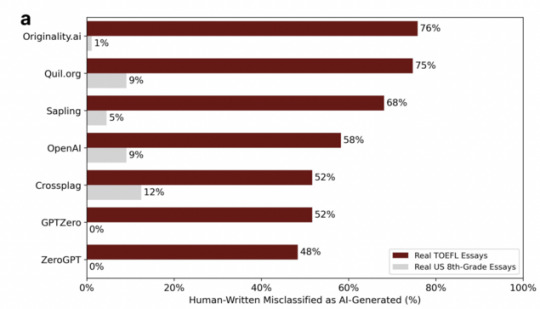
It is irresponsible to use AI-generated text detectors as evidence of academic misconduct, and that's putting it mildly.
#neural networks#gpt detector#bias#bias against non-native speakers#false positive#not only is it often just wrong#but it's wrong in a way that's biased against non-native speakers#stop using gpt detectors to detect cheating#stop it#feel free to print this out and hang it up at school
15K notes
·
View notes
Text
Detect ai generated text for Free, simple way & High accuracy. Ai content check, ai content detection tool, ai essay detector for teacher.
0 notes
Text
An AI Detector is a tool that uses a vast datasets of information to determine whether a piece of text is genuinely human-writtten or if it's AI-generated.
#chatgpt tester#chat gpt zero check#check for ai generated text#ai checker#anti chat gpt#anti chatgpt detector
0 notes
Text
Often when I post an AI-neutral or AI-positive take on an anti-AI post I get blocked, so I wanted to make my own post to share my thoughts on "Nightshade", the new adversarial data poisoning attack that the Glaze people have come out with.
I've read the paper and here are my takeaways:
Firstly, this is not necessarily or primarily a tool for artists to "coat" their images like Glaze; in fact, Nightshade works best when applied to sort of carefully selected "archetypal" images, ideally ones that were already generated using generative AI using a prompt for the generic concept to be attacked (which is what the authors did in their paper). Also, the image has to be explicitly paired with a specific text caption optimized to have the most impact, which would make it pretty annoying for individual artists to deploy.
While the intent of Nightshade is to have maximum impact with minimal data poisoning, in order to attack a large model there would have to be many thousands of samples in the training data. Obviously if you have a webpage that you created specifically to host a massive gallery poisoned images, that can be fairly easily blacklisted, so you'd have to have a lot of patience and resources in order to hide these enough so they proliferate into the training datasets of major models.
The main use case for this as suggested by the authors is to protect specific copyrights. The example they use is that of Disney specifically releasing a lot of poisoned images of Mickey Mouse to prevent people generating art of him. As a large company like Disney would be more likely to have the resources to seed Nightshade images at scale, this sounds like the most plausible large scale use case for me, even if web artists could crowdsource some sort of similar generic campaign.
Either way, the optimal use case of "large organization repeatedly using generative AI models to create images, then running through another resource heavy AI model to corrupt them, then hiding them on the open web, to protect specific concepts and copyrights" doesn't sound like the big win for freedom of expression that people are going to pretend it is. This is the case for a lot of discussion around AI and I wish people would stop flagwaving for corporate copyright protections, but whatever.
The panic about AI resource use in terms of power/water is mostly bunk (AI training is done once per large model, and in terms of industrial production processes, using a single airliner flight's worth of carbon output for an industrial model that can then be used indefinitely to do useful work seems like a small fry in comparison to all the other nonsense that humanity wastes power on). However, given that deploying this at scale would be a huge compute sink, it's ironic to see anti-AI activists for that is a talking point hyping this up so much.
In terms of actual attack effectiveness; like Glaze, this once again relies on analysis of the feature space of current public models such as Stable Diffusion. This means that effectiveness is reduced on other models with differing architectures and training sets. However, also like Glaze, it looks like the overall "world feature space" that generative models fit to is generalisable enough that this attack will work across models.
That means that if this does get deployed at scale, it could definitely fuck with a lot of current systems. That said, once again, it'd likely have a bigger effect on indie and open source generation projects than the massive corporate monoliths who are probably working to secure proprietary data sets, like I believe Adobe Firefly did. I don't like how these attacks concentrate the power up.
The generalisation of the attack doesn't mean that this can't be defended against, but it does mean that you'd likely need to invest in bespoke measures; e.g. specifically training a detector on a large dataset of Nightshade poison in order to filter them out, spending more time and labour curating your input dataset, or designing radically different architectures that don't produce a comparably similar virtual feature space. I.e. the effect of this being used at scale wouldn't eliminate "AI art", but it could potentially cause a headache for people all around and limit accessibility for hobbyists (although presumably curated datasets would trickle down eventually).
All in all a bit of a dick move that will make things harder for people in general, but I suppose that's the point, and what people who want to deploy this at scale are aiming for. I suppose with public data scraping that sort of thing is fair game I guess.
Additionally, since making my first reply I've had a look at their website:
Used responsibly, Nightshade can help deter model trainers who disregard copyrights, opt-out lists, and do-not-scrape/robots.txt directives. It does not rely on the kindness of model trainers, but instead associates a small incremental price on each piece of data scraped and trained without authorization. Nightshade's goal is not to break models, but to increase the cost of training on unlicensed data, such that licensing images from their creators becomes a viable alternative.
Once again we see that the intended impact of Nightshade is not to eliminate generative AI but to make it infeasible for models to be created and trained by without a corporate money-bag to pay licensing fees for guaranteed clean data. I generally feel that this focuses power upwards and is overall a bad move. If anything, this sort of model, where only large corporations can create and control AI tools, will do nothing to help counter the economic displacement without worker protection that is the real issue with AI systems deployment, but will exacerbate the problem of the benefits of those systems being more constrained to said large corporations.
Kinda sucks how that gets pushed through by lying to small artists about the importance of copyright law for their own small-scale works (ignoring the fact that processing derived metadata from web images is pretty damn clearly a fair use application).
1K notes
·
View notes
Text
AI Gen Text Detector: Defending Against Misinformation with Precision
ZeroGPT introduces an advanced "AI Generated Text Detector," ensuring precise identification and management of AI-generated textual content. Trust in our platform for accurate scrutiny, setting new benchmarks for reliability and authenticity in the evolving landscape of AI-generated text.

0 notes
Text
Beware of the new art book scams
Hey there, I'm putting together a little PSA. Art book ads can no longer be trusted. I recently got an ad for an art book from a company called Comicpencil. The book is all AI generated content. I didn't purchase it, but after digging I found a youtube video from an artist called Jazza pointing out that there is no credit to any artists anywhere. He purchased the book and pointed out that a lot of the text content also makes very little sense.

I tried commenting on the ad pointing out that it was AI generated and my post was instantly deleted and I was blocked. I think they have some kind of detecting software that flags any mention of AI on their ads to keep up the charade. Here's one of their posts on one of the better AI image detectors, Hivemoderation. I know these things aren't always accurate but they can definitely help indicate AI if the results are consistent enough. I tested a few I could find that weren't obscured to hell and sure enough they all came out with these results.
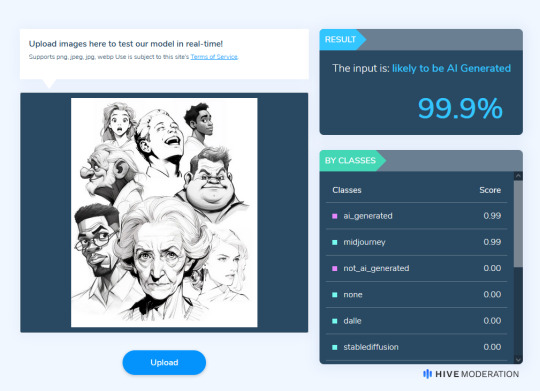
Please. I urge you to share this. Scams in general are going to be getting worse thanks to AI and it's really important people are aware of this. Be vigilant.
815 notes
·
View notes
Text
Thinking about that that "slop accelerationism" post, and also Scott's AI art Turing test.
I also hope AI text- and image-generation will help shake us loose from cheap bad art. For example, the fact that you can now generate perfectly rendered anime girls at the click of button kindof suggests that there was never much content in those drawings. Though maybe we didn't really need AI for that insight? It feels very similar to that shift in fashion that rejected Bouguereau-style laboriously-rendered pretty girls in favor of more sketchy brush work.
But will we really be so lucky that only things that we already suspected was slop will prove valueless?
As usual with AI, Douglas Hofstadter already thought about this a long time ago, in an essay from 2001. Back in 1979 he had written
Will a computer program ever write beautiful music? Speculation: Yes, but not soon. Music is a language of emotions, and until programs have emotions as complex as ours, there is no way a program will write anything beautiful. There can be "forgeries"—shallow imitations of the syntax of earlier music—but despite what one might think at first, there is much more to musical expression than can be captured in syntactical rules. There will be no new kinds of beauty turned up for a long time by computer music-composing programs. Let me carry this thought a little further. To think—and I have heard this suggested—that we might soon be able to command a preprogrammed mass-produced mail-order twenty-dollar desk-model "music box" to bring forth from its sterile [sic!] circuitry pieces which Chopin or Bach might have written had they lived longer is a grotesque and shameful misestimation of the depth of the human spirit. A "program" which could produce music as they did would have to wander around the world on its own, fighting its way through the maze of life and feeling every moment of it. It would have to understand the joy and loneliness of a chilly night wind, the longing for a cherished hand, the inaccessibility of a distant town, the heartbreak and regeneration after a human death. It would have to have known resignation and world-weariness, grief and despair, determination and victory, piety and awe. In it would have had to commingle such opposites as hope and fear, anguish and jubilation, serenity and suspense. Part and parcel of it would have to be a sense of grace, humor, rhythm, a sense of the unexpected and of course an exquisite awareness of the magic of fresh creation. Therein, and therein only, lie the sources of meaning in music.
I think this is helpful in pinning down what we would have liked to be true. Because in 1995, somebody wrote a program that generates music by applying simple syntactic rules to combine patterns from existing pieces, and it sounded really good! (In fact, it passed a kind of AI art turing test.) Oops!
The worry, then, is that we just found out that the computer has as complex emotions as us, and they aren't complex at all. It would be like adversarial examples for humans: the noise-like pattern added to the panda doesn't "represent" a gibbon, it's an artifact of the particular weights and topology of the image recognizer, and the resulting classification doesn't "mean" anything. Similarly, Arnulf Rainer wrote that when he reworked Wine-Crucifix, "the quality and truth of the picture only grew as it became darker and darker"—doesn't this sound a bit like gradient descent? Did he stumble on a pattern that triggers our "truth" detector, even though the pattern is merely a shallow stimulus made of copies of religious iconography that we imprinted on as kids?
One attempt to recover is to say Chopin really did write music based on the experience of fighting through the maze of life, and it's just that philistine consumers can't tell the difference between the real and the counterfeit. But this is not very helpful, it means that we were fooling ourselves, and the meaning that we imagined never existed.
More promising, maybe the program is a "plagiarism machine", which just copies the hard-won grief, despair, world-weariness &c that Chopin recorded? On its own it's not impressive that a program can output an image indistinguishable from Gauguin's, I can write such a program in a single line:
print("https://commons.wikimedia.org/wiki/File:Gauguin,Paul-Still_Life_with_Profile_of_Laval-_Google_Art_Project.jpg")
I think this is the conclusion that Hofstadter leans towards: the value of Chopin and the other composers was to discover the "template" that can then be instantiated to make many beautiful music pieces. Kind of ironically, this seems to push us back to some very turn-of-the-20th-century notion of avant-garde art. Each particular painting that (say) Monet executed is of low value, and the actual valuable thing is the novel art style...
That view isn't falsified yet, but it feels precarious. You could have said that AlphaGo was merely a plagiarism machine that selected good moves from historical human games, except then AlphaGo Zero proved that the humans were superfluous after all. Surely a couple of years from now somebody might train an image model on a set of photographs and movies excluding paintings, and it might reinvent impressionism from first principles, and then where will we be? Better start prepare a fallback-philosophy now.
130 notes
·
View notes
Text
Some thoughts on Cara
So some of you may have heard about Cara, the new platform that a lot of artists are trying out. It's been around for a while, but there's been a recent huge surge of new users, myself among them. Thought I'd type up a lil thing on my initial thoughts.
First, what is Cara?
From their About Cara page:
Cara is a social media and portfolio platform for artists. With the widespread use of generative AI, we decided to build a place that filters out generative AI images so that people who want to find authentic creatives and artwork can do so easily. Many platforms currently accept AI art when it’s not ethical, while others have promised “no AI forever” policies without consideration for the scenario where adoption of such technologies may happen at the workplace in the coming years. The future of creative industries requires nuanced understanding and support to help artists and companies connect and work together. We want to bridge the gap and build a platform that we would enjoy using as creatives ourselves. Our stance on AI: ・We do not agree with generative AI tools in their current unethical form, and we won’t host AI-generated portfolios unless the rampant ethical and data privacy issues around datasets are resolved via regulation. ・In the event that legislation is passed to clearly protect artists, we believe that AI-generated content should always be clearly labeled, because the public should always be able to search for human-made art and media easily.
Should note that Cara is independently funded, and is made by a core group of artists and engineers and is even collaborating with the Glaze project. It's very much a platform by artists, for artists!
Should also mention that in being a platform for artists, it's more a gallery first, with social media functionalities on the side. The info below will hopefully explain how that works.
Next, my actual initial thoughts using it, and things that set it apart from other platforms I've used:
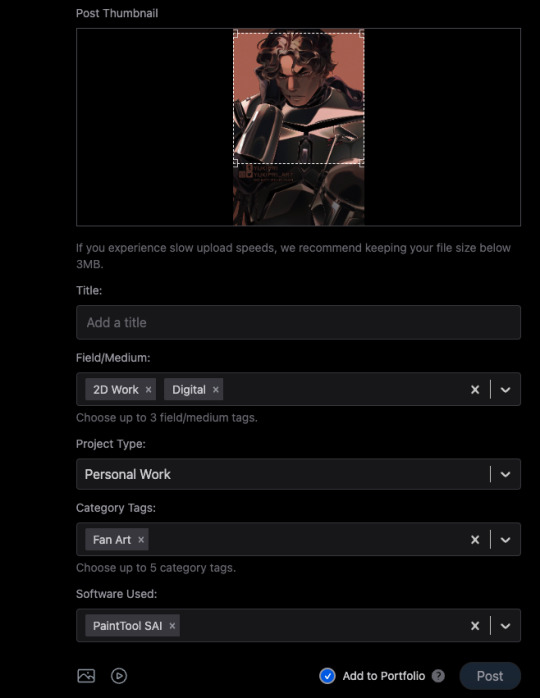
1) When you post, you can choose to check the portfolio option, or to NOT check it. This is fantastic because it means I can have just my art organized in my gallery, but I can still post random stuff like photos of my cats and it won't clutter things. You can also just ramble/text post and it won't affect the gallery view!
2) You can adjust your crop preview for your images. Such a simple thing, yet so darn nice.
3) When you check that "Add to portfolio," you get a bunch of additional optional fields: Title, Field/Medium, Project Type, Category Tags, and Software Used. It's nice that you can put all this info into organized fields that don't take up text space.
4) Speaking of text, 5000 character limit is niiiiice. If you want to talk, you can.
5) Two separate feeds, a "For You" algorithmic one, and "Following." The "Following" actually appears to be full chronological timeline of just folks you follow (like Tumblr). Amazing.
6) Now usually, "For You" being set to home/default kinda pisses me off because generally I like curating my own experience, but not here, for this handy reason: if you tap the gear symbol, you can ADJUST your algorithm feed!
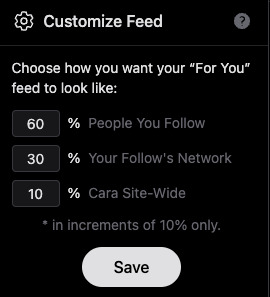
So you can choose what you see still!!! AMAZING. And, again, you still have your Following timeline too.
7) To repeat the stuff at the top of this post, its creation and intent as a place by artists, for artists. Hopefully you can also see from the points above that it's been designed with artists in mind.
8) No GenAI images!!!! There's a pop up that says it's not allowed, and apparently there's some sort of detector thing too. Not sure how reliable the latter is, but so far, it's just been a breath of fresh air, being able to scroll and see human art art and art!
To be clear, Cara's not perfect and is currently pretty laggy, and you can get errors while posting (so far, I've had more success on desktop than the mobile app), but that's understandable, given the small team. They'll need time to scale. For me though, it's a fair tradeoff for a platform that actually cares about artists.
Currently it also doesn't allow NSFW, not sure if that'll change given app store rules.
As mentioned above, they're independently funded, which means the team is currently paying for Cara itself. They have a kofi set up for folks who want to chip in, but it's optional. Here's the link to the tweet from one of the founders:
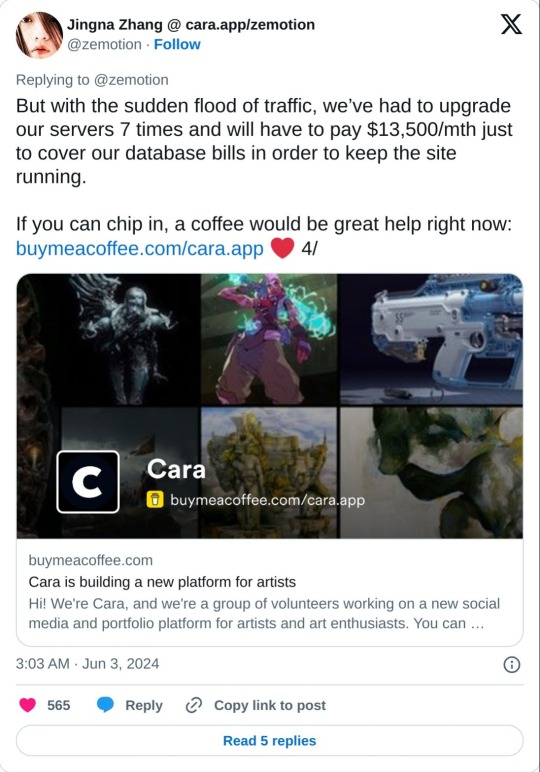
And a reminder that no matter that the platform itself isn't selling our data to GenAI, it can still be scraped by third parties. Protect your work with Glaze and Nightshade!
Anyway, I'm still figuring stuff out and have only been on Cara a few days, but I feel hopeful, and I think they're off to a good start.
I hope this post has been informative!
Lastly, here's my own Cara if you want to come say hi! Not sure at all if I'll be active on there, but if you're an artist like me who is keeping an eye out for hopefully nice communities, check it out!
#YukiPri rambles#cara#cara app#social media#artists on tumblr#review#longpost#long post#mostly i'd already typed this up on twitter so i figured why not share it here too#also since tumblr too is selling our data to GenAI
180 notes
·
View notes
Text
Hello, everyone!
First off, I’m sorry for even having to post this, and I’m usually nice to everyone I come into contact with, but I received a startling comment on my newest fic, Paint-Stained Hands and Paper Hearts, where I was accused of pumping out the entire chapter solely using AI.
I am thirty-two years old and have been attending University since I was 18 YEARS OLD. I am currently working on obtaining my PhD in English Literature as well as a Masters in Creative Writing. So, there’s that.
There is an increasing trend of online witch hunts targeting writers on all platforms (fanfic.net, ao3, watt pad, etc), where people will accuse them of utilizing AI tools like ChatGPT and otherwise based solely on their writing style or prose. These accusations often come without concrete evidence and rely on AI detection tools, which are known to be HELLA unreliable. This has led to false accusations against authors who have developed a particular writing style that AI models may emulate due to the vast fucking amount of human-written literature that they’ve literally had dumped into them. Some of these people are friends of mine, some of whom are well-known in the AO3 writing community, and I received my first comment this morning, and I’m pissed.
AI detection tools work by analyzing text for patterns, probabilities, and structures that resemble AI-generated outputs. HOWEVER, because AI models like ChatGPT are trained on extensive datasets that include CENTURIES of literature, modern writing guides, and user-generated content, they inevitably produce text that can mimic various styles — both contemporary and historical. Followin’ me?
To dumb this down a bit, it means that AI detection tools are often UNABLE TO DISTINGUISH between human and AI writing with absolute certainty.
Furthermore, tests have shown that classic literary works, like those written by Mary Shelley, Jane Austen, William Shakespeare, and Charles Dickens, frequently trigger AI detectors as being 100% AI generated or plagiarized. For example:
Mary Shelley’s Frankenstein has been flagged as AI-generated because its formal, structured prose aligns with common AI patterns.
Jane Austen’s novels, particularly Pride and Prejudice, often receive high AI probability scores due to their precise grammar, rhythmic sentence structures, and commonly used words in large language models.
Shakespeare’s works sometimes trigger AI detectors given that his poetic and structured style aligns with common AI-generated poetic forms.
Gabriel Garcia Marquez’s Love in the Time of Cholera and One Hundred Years of Solitude trigger 100% AI-generated due to its flowing sentences, rich descriptions, and poetic prose, which AI models often mimic when generating literary or philosophical text.
Fritz Leiber’s Fafhrd and the Grey Mouser’s sharp, structured rhythmic prose, imaginative world building, literary elegance, and dialogue-driven narratives often trigger 100% on AI detectors.
The Gettysburg fucking Address by Abraham Lincoln has ALSO been miss classified as AI, demonstrating how formal, structured language confuses these detectors.
These false positives reveal a critical flaw in AI detection: because AI has been trained on so much human writing, it is nearly impossible for these tools to completely separate original human work from AI-generated text. This becomes more problematic when accusations are directed at contemporary authors simply because their writing ‘feels’ like AI despite being fully human.
The rise in these accusations poses a significant threat to both emerging and established writers. Many writers have unique styles that might align with AI-generated patterns, especially if they follow conventional grammar, use structured prose, or have an academic or polished writing approach. Additionally, certain genres— such as sci-fi, or fantasy, or philosophical essays— often produce high AI probability scores due to their abstract and complex language.
For many writers, their work is a reflection of years—often decades—of dedication, practice, and personal growth. To have their efforts invalidated or questioned simply because their writing is mistaken for AI-generated text is fucking disgusting.
This kind of shit makes people afraid of writing, especially those who are just starting their careers / navigating the early stages of publication. The fear of being accused of plagiarism, or of relying on AI for their creativity is anxiety-inducing and can tank someone’s self esteem. It can even stop some from continuing to write altogether, as the pressure to prove their authenticity becomes overwhelming.
For writers who have poured their hearts into their work, the idea that their prose could be mistaken for something that came from a machine is fucking frustrating. Second-guessing your own style, wondering if you need to change how you write or dumb it down in order to avoid being falsely flagged—this fear of being seen as inauthentic can stifle their creative process, leaving them hesitant to share their work or even finish projects they've started. This makes ME want to stop, and I’m just trying to live my life, and write about things I enjoy. So, fuck you very much for that.
Writing is often a deeply personal endeavor, and for many, it's a way to express thoughts, emotions, and experiences that are difficult to put into words. When those expressions are wrongly branded as artificial, it undermines not just the quality of their work but the value of their creative expression.
Consider writing habits, drafts, and personal writing history rather than immediate and unfounded accusations before you decide to piss in someone’s coffee.
So, whatever. Read my fics, don’t read my fics. I just write for FUN, and to SHARE with all of you.
Sorry that my writing is too clinical for you, ig.
I put different literary works as well as my own into an AI Detector. Here you go.
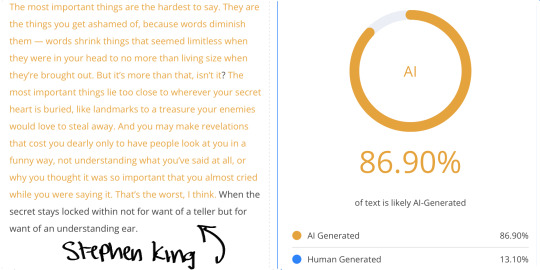
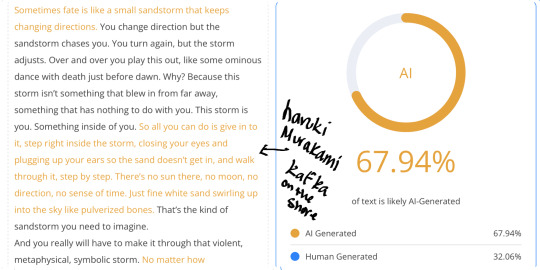
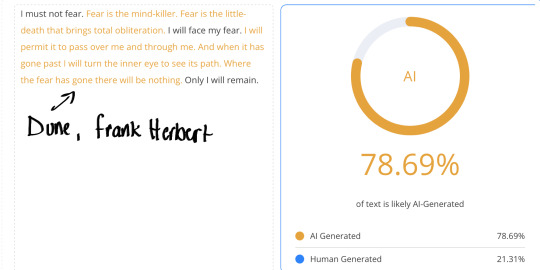
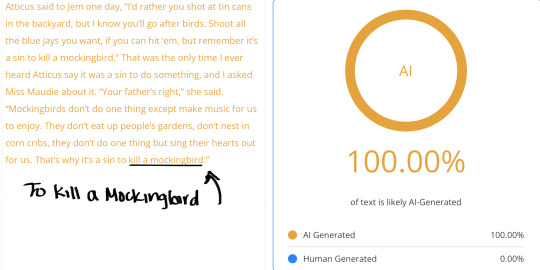
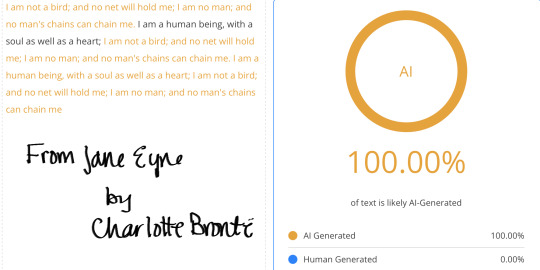
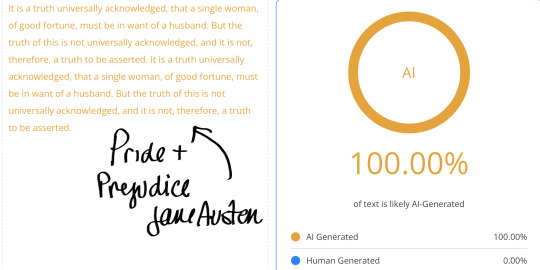
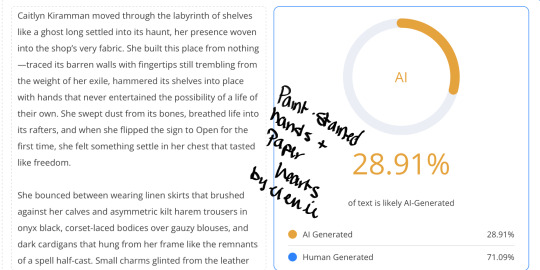
#arcane#ao3 fanfic#arcane fanfic#ao3#ao3 writer#writers on tumblr#writing#wattpad#fanfiction#arcane fanfiction
49 notes
·
View notes